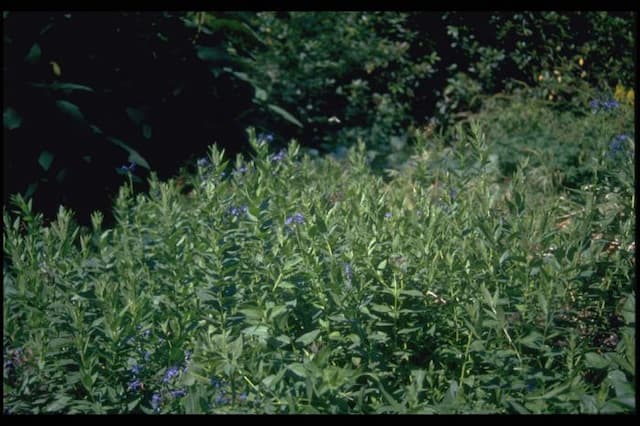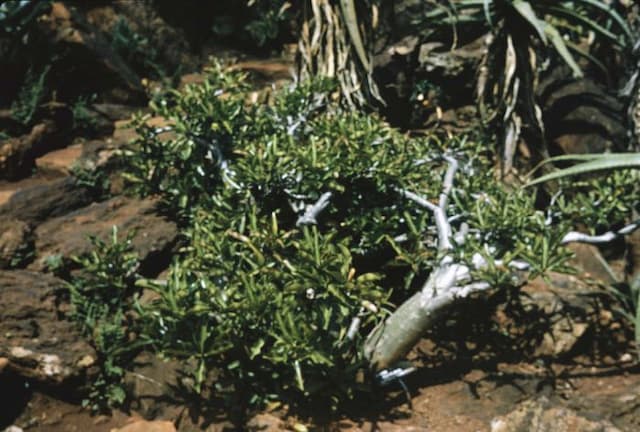Silkvine Periploca graeca

ABOUT
The plant known as the silk vine has a distinctive climbing habit, often using other plants or structures as support to spread its foliage. It possesses twining stems that help it to securely anchor and climb. On these stems, the leaves are arranged opposite one another, displaying an attractive dark green color. Each leaf is oval-shaped with pointed tips, giving them a sleek appearance. During its blooming season, the silk vine flourishes with clusters of small, star-shaped flowers. These flowers are a notable feature for their intricate structure and a blend of colors, usually cream or pale yellow, often with a purplish center that adds a touch of allure to the plant. As with many flowering vines, after the blossoming period, the plant will bear fruit. The silk vine produces slender, bean-like pods that contain numerous seeds. These pods have a silky interior lining, which has contributed to the common name of the plant. The fruits mature to a brown color and persist on the vine, adding to the visual interest even after the flowers have faded.
About this plant
 Names
NamesFamily
Apocynaceae
Synonyms
Silk Vine, Greek Silk Vine
Common names
Periploca angustifolia, Periploca graeca var. angustifolia.
 Toxicity
ToxicityTo humans
The plant known as silkvine (Periploca graeca) contains cardiac glycosides, which can be toxic to humans if ingested. These compounds can affect the heart muscle, leading to symptoms that may include nausea, vomiting, abdominal pain, diarrhea, and in severe cases, cardiac arrhythmias which can be potentially life-threatening. Care should be taken to avoid ingestion of any part of the silkvine plant due to its potential toxicity.
To pets
Silkvine (Periploca graeca) is also toxic to pets, including cats and dogs, due to the cardiac glycosides it contains. If a pet ingests any part of the silkvine plant, it may exhibit symptoms such as vomiting, diarrhea, abdominal pain, drooling, loss of appetite, and severe cardiac abnormalities, which include changes in heart rate and rhythm. These symptoms can be serious and warrant immediate veterinary attention to prevent potentially lethal consequences.
 Characteristics
CharacteristicsLife cycle
Perennials
Foliage type
Deciduous
Color of leaves
Green
Flower color
Purple
Height
6-9 feet (1.8-2.7 meters)
Spread
6-12 feet (1.8-3.6 meters)
Plant type
Climber
Hardiness zones
7
Native area
Mediterranean
Benefits
 General Benefits
General Benefits- Drought Resistance: Periploca graeca has the ability to survive in dry environments with minimal water supply.
- Soil Erosion Control: Its root system helps in stabilizing soil and preventing erosion.
- Landscape Aesthetics: Silky Dogbane is often used for ornamental purposes because of its attractive flowers and foliage.
- Habitat for Wildlife: It provides food and habitat for various insects and birds.
- Low Maintenance: Requires little care once established, making it ideal for low-maintenance landscaping.
- Tolerant of Poor Soils: Can grow in less fertile soils, expanding the range of areas where it can be cultivated.
 Medical Properties
Medical Properties- Anticancer activity: Some compounds found in Periploca graeca have been studied for their anticancer properties.
- Antioxidant properties: The plant may contain antioxidants that help in scavenging free radicals from the body.
- Anti-inflammatory effects: Periploca graeca may have anti-inflammatory properties that could help reduce inflammation.
- Cardiotonic effect: It has been traditionally used to exhibit cardiotonic activity, potentially affecting heart function.
- Antimicrobial activity: Extracts from the plant could have antimicrobial properties against certain pathogens.
- Immune system modulation: Some elements in Periploca graeca might influence the immune system.
- Antidiabetic potential: There may be potential for the plant to affect blood sugar levels.
 Air-purifying Qualities
Air-purifying QualitiesThis plant is not specifically known for air purifying qualities.
 Other Uses
Other Uses- Periploca graeca, also known as silk vine, has been traditionally used in basketry due to its strong and flexible stems that can be woven into various shapes.
- The fibers extracted from the bark of silk vine can be utilized in the manufacture of ropes and twines, offering a natural and durable option for tying and binding materials.
- With its attractive foliage and flowers, silk vine is often cultivated as an ornamental plant to enhance the aesthetics of gardens and parks.
- In regions where silk vine is native, the wood can be employed in making small wooden articles and crafts, capitalizing on its hardness when dried properly.
- Due to its climbing nature, silk vine is used in landscaping to cover fences and pergolas, providing shade and privacy in outdoor living spaces.
- The leaves of silk vine have been used as fodder for livestock in some cultures, serving as an additional food source especially when other forage is scarce.
- Its robust nature allows silk vine to be used in soil erosion control projects, where its root system helps stabilize the soil on slopes and embankments.
- Silk vine has been harnessed for studying phytoremediation potential, exploring its capability to uptake and accumulate certain heavy metals from contaminated soils.
- Some artisans may use silk vine's attractive seed pods in dry floral arrangements, adding a unique and natural element to their designs.
- The plant has been historically used in tanning leather, where its compounds help in processing animal hides into leather products.
Interesting Facts
 Feng Shui
Feng ShuiThe Silk Vine is not used in Feng Shui practice.
 Zodiac Sign Compitability
Zodiac Sign CompitabilityThe Silk Vine is not used in astrology practice.
 Plant Symbolism
Plant Symbolism- Protection: Periploca graeca, commonly known as silk vine, is often associated with protection. In some traditions, it's believed that planting this vine near one's home can offer a protective shield against negative energies or misfortune.
- Endurance: Due to its hardy nature and ability to thrive in tough conditions, the silk vine is symbolically linked to endurance and the ability to withstand challenges over time.
- Adaptability: The silk vine's capacity to adapt to various environments symbolizes flexibility and the skill of adjusting to changing circumstances gracefully.
- Longevity: As a plant that can live and grow for many years, the silk vine represents longevity and sustained health or well-being.
- Connection: The climbing habit of the silk vine, which often intertwines with other plants, can symbolize the interconnectedness of life and the importance of relationships and support systems.
 Water
WaterThe Silk Vine should be watered thoroughly once the top inch of soil has dried out; this usually means watering roughly once a week during the growing season and reducing to once every two weeks or less during the dormant winter period. When watering, aim to provide enough water until it begins to run out of the drainage holes, which might be around 1 to 1.5 gallons for a medium-sized container. It's crucial not to let the Silk Vine sit in water, as this can lead to root rot, so always empty the saucer shortly after watering.
 Light
LightSilk Vine thrives best in bright, indirect light conditions. It should be placed in a location where it can receive plenty of light but protected from the direct harsh rays of the sun, especially during the peak hours of the afternoon. A spot near a south-facing window with some sort of light filtering, like sheer curtains, would be ideal for this plant.
 Temperature
TemperatureSilk Vine prefers temperatures between 60 and 85 degrees Fahrenheit. It can survive a minimum temperature down to about 50 degrees Fahrenheit; however, cold drafts and temperatures below this range should be avoided. The ideal temperature range promotes healthy growth and blooming.
 Pruning
PruningPruning Silk Vine is necessary to control its size, encourage bushier growth, and remove any dead or damaged stems. The best time to prune is in late winter or early spring before new growth starts. Pruning can be done annually, but light trimming can be done throughout the year as needed.
 Cleaning
CleaningAs needed
 Soil
SoilSilk vine thrives in a well-draining soil mix, with a pH level ranging from neutral to slightly alkaline (7.0-8.0). A mixture of loamy garden soil, peat, and sharp sand or perlite can create an ideal growing environment, promoting good drainage and aeration.
 Repotting
RepottingSilk vine requires repotting every two to three years to refresh the soil and to accommodate root growth. This consistent repotting schedule helps to maintain the plant's health and vigor.
 Humidity & Misting
Humidity & MistingSilk vine prefers moderate humidity levels but is relatively adaptable and can tolerate the drier air typical of indoor environments. However, ensuring some humidity can promote lush growth and a healthier plant.
 Suitable locations
Suitable locationsIndoor
Place silk vine in bright, indirect light and maintain moderate humidity.
Outdoor
Plant silk vine in sunlight or partial shade and well-draining soil.
Hardiness zone
Silk vine is suitable for USDA zones 7-10.
 Life cycle
Life cyclePeriploca graeca, commonly known as silk vine, begins its life cycle as a seed which, when conditions are favorable, germinates and develops a root system and a shoot that grows toward the light. The plant then enters the vegetative stage, growing leaves and stems as it becomes a young vine, climbing on supports with the help of its twining stems. During the flowering stage, silk vine produces small, purplish-brown flowers usually in the late spring or early summer, which are pollinated by insects and can lead to the development of seed pods. Once pollinated, the flowers give way to slender, elongated seed pods containing seeds with silky tufts that are dispersed by wind. After reaching maturity and producing seeds, the plant enters a period of dormancy, especially in colder climates, where it may lose leaves or appear to die back until favorable growing conditions return. Silk vine can live for many years, going through the cycle of vegetative growth, flowering, and dormancy annually.
 Propogation
PropogationPropogation time
Spring-Early Summer
Propogation: The most popular method of propagation for Periploca graeca, commonly known as the Silk Vine, is through semi-hardwood cuttings. This is typically done in summer when the plant is actively growing. To propagate the Silk Vine, take semi-hardwood cuttings of about 4 to 6 inches (10 to 15 centimeters) in length, ensuring that each cutting has at least two to three leaf nodes. Strip the leaves from the bottom half of the cuttings to prevent excess moisture loss and possible rot. Dip the cut end into a rooting hormone to enhance root development, then plant the cuttings in a well-draining soil mix, ensuring that at least one leaf node is below the soil surface to facilitate root growth. The cuttings should be kept in a warm, humid environment with indirect light until they have rooted, which usually takes a few weeks. Once rooted, the cuttings can be potted up individually and gradually acclimatized to outdoor conditions if that is their intended final location.




![Star jasmine [Star of Toscana]](/_next/image?url=https%3A%2F%2Fplants-admin.emdemapps.com%2Fimages%2Fplants%2F%2Fimages%2F604b62fa574d4.png&w=640&q=75)




